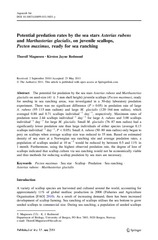| dc.contributor.author | Magnesen, Thorolf | eng |
| dc.contributor.author | Redmond, Kirsten Jayne | eng |
| dc.date.accessioned | 2012-01-18T09:29:36Z | |
| dc.date.available | 2012-01-18T09:29:36Z | |
| dc.date.issued | 2012 | eng |
| dc.identifier.issn | 0967-6120 | en_US |
| dc.identifier.uri | http://hdl.handle.net/1956/5446 | |
| dc.description.abstract | The potential for predation by the sea stars Asterias rubens and Marthasterias glacialis on seed-size (41 ± 3 mm shell height) juvenile scallops (Pecten maximus), ready for seeding in sea ranching areas, was investigated in a 30-day laboratory predation experiment. There was no significant difference (P[0.05) in predation rate of large A. rubens (95–115 mm radium) and large M. glacialis (120–164 mm radius), which averaged 0.88 and 0.71 scallops individual-1 day-1, respectively. Maximum rates of predation were 2.44 scallops individual-1 day-1 for large A. rubens and 3.00 scallops individual-1 day-1 for large M. glacialis. Small M. glacialis (76–87 mm radius) had a significantly lower predation rate than large individuals of either species (average 0.13 scallops individual-1 day-1, P\0.05). Small A. rubens (50–80 mm radius) only began to prey on scallops when average scallop size was reduced to 35 mm. Based on estimated density of sea stars at a Norwegian sea ranching site and average predation rates, a population of scallops seeded at 10 m-2 would be reduced by between 0.5 and 11% in 1 month. Furthermore, using the highest observed predation rate, the degree of loss of scallops indicated that scallop culture via sea ranching would not be economically viable and thus methods for reducing scallop predation by sea stars are necessary. | en_US |
| dc.language.iso | eng | eng |
| dc.publisher | Springer | en_US |
| dc.rights | Creative Commons Attribution Noncommercial | |
| dc.rights.uri | https://creativecommons.org/licenses/by-nc/2.0 | eng |
| dc.subject | Pecten maximus | eng |
| dc.subject | Scallop | eng |
| dc.subject | Sea ranching | eng |
| dc.subject | Asterias rubens | eng |
| dc.subject | Marthasterias glacialis | eng |
| dc.title | Potential predation rates by the sea stars Asterias rubens and Marthasterias glacialis, on juvenile scallops, Pecten maximus, ready for sea ranching | en_US |
| dc.type | Peer reviewed | |
| dc.type | Journal article | |
| dc.description.version | publishedVersion | en_US |
| dc.rights.holder | Copyright the Author(s) 2011 | en_US |
| dc.identifier.doi | https://doi.org/10.1007/s10499-011-9451-y | |
| dc.identifier.cristin | 840700 | |
| dc.source.journal | Aquaculture International | |
| dc.source.pagenumber | 189-199 | |
| dc.subject.nsi | VDP::Mathematics and natural science: 400::Zoology and botany: 480::Marine biology: 497 | en_US |
| dc.identifier.citation | Aquaculture International 20(1): 189-199 | |
| dc.source.volume | 20 | |

